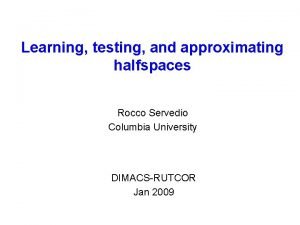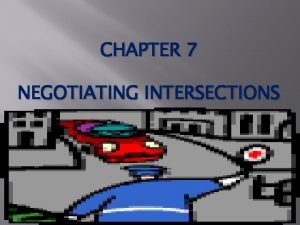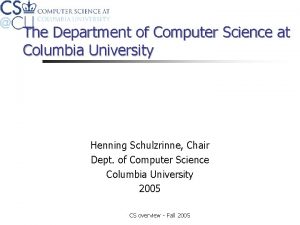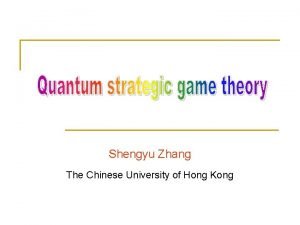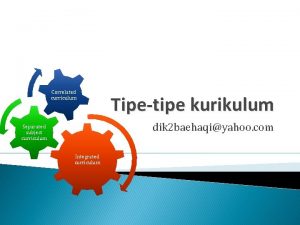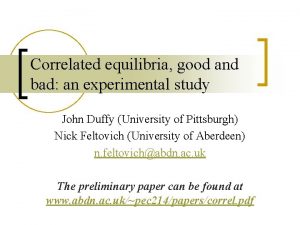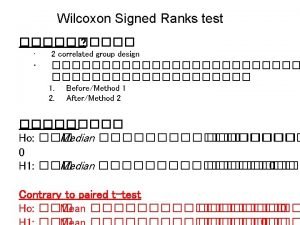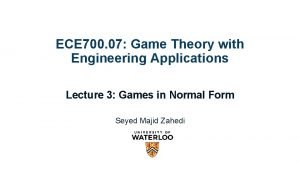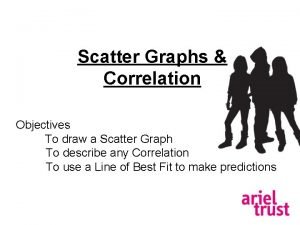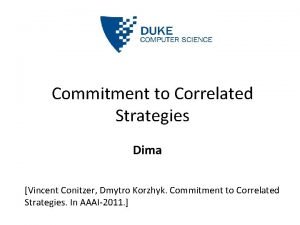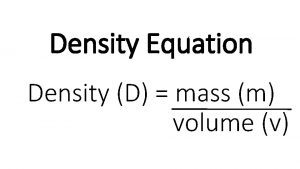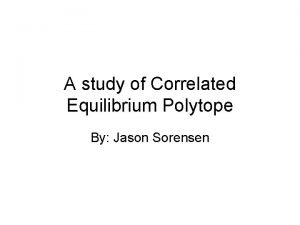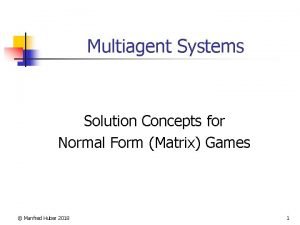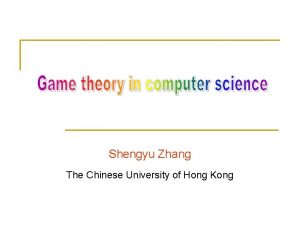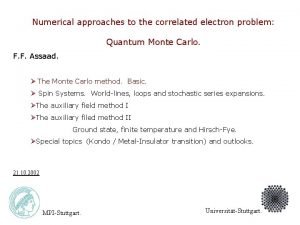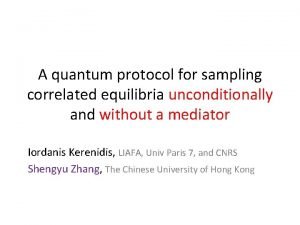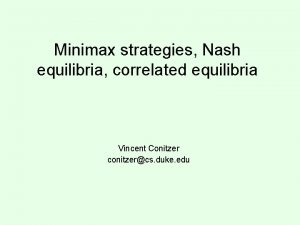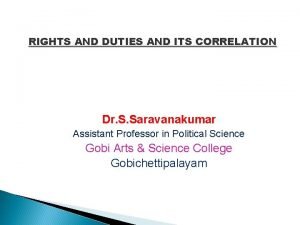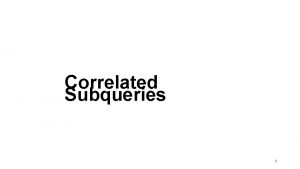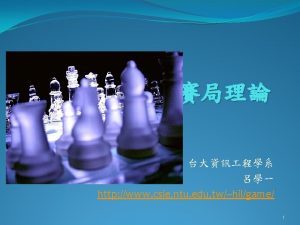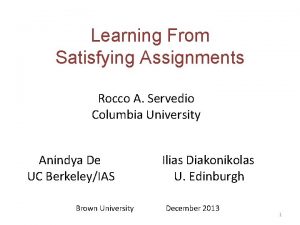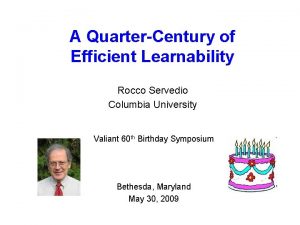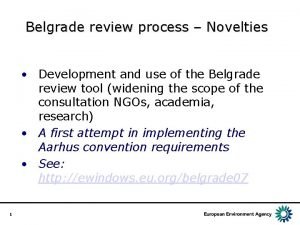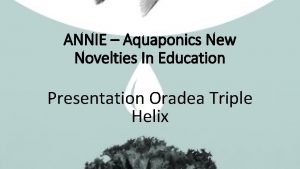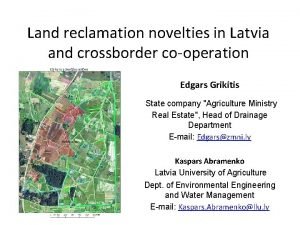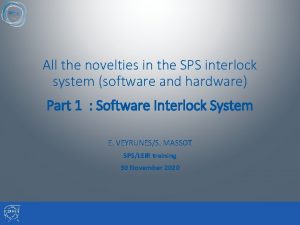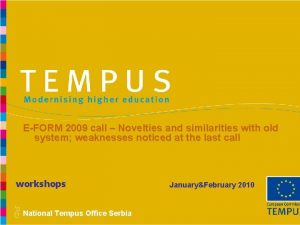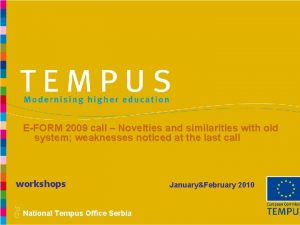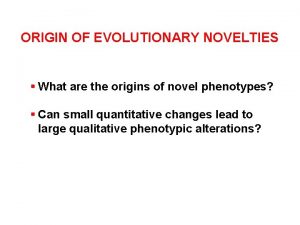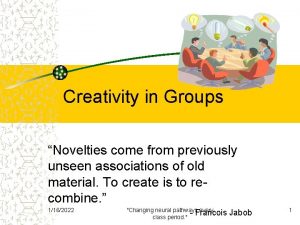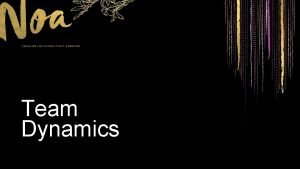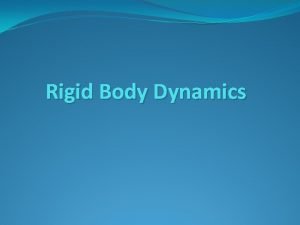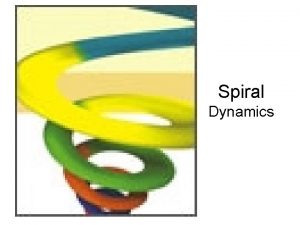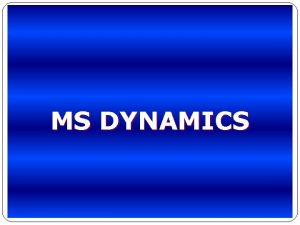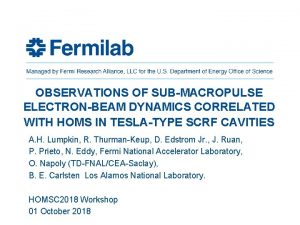The dynamics of correlated novelties with V Servedio



































- Slides: 35

The dynamics of correlated novelties with V. Servedio S. Strogatz F. Tria Vittorio Loreto Sapienza University of Rome ISI Foundation, Turin

Bio-techno-social systems community level social, interactive infrastructure level user level cognitive, behavioural, biologic ICT, networks, physical-digital

A new platform for web-gaming and social computation http: //www. everyaware. eu/

Biology Social systems Technology Arts, Science, Architecture, Urbanism, . .

Tinkering Serendipity Diffusion Success Exaptation Trial and Error Mutation / Fixation Ahead of time Multiples

Our lives are spiced with little novelties. . . a new song a new book a new person a new word a new web page. . . and often one thing leads to another one innovation sets the stage for another

Adjacent possible Consists of all those things (depending on the context, these could be ideas, molecules, genomes, technological products, etc. ) that are one step away from what actually exists, and hence can arise from incremental modifications and recombinations of existing material. The strange and beautiful truth about the adjacent possible is that its boundaries grow as you explore those boundaries. S. A. Kauffman, Investigations (Oxford University Press, New York/Oxford, 2000).

A mathematical framework for the adjacent possible

Is the adjacent possible for real ? Can we find its signature in reality ? Can we model it ?

natural texts

natural texts Let us imagine a language. . . The language is meant to serve for communication between a builder A and an assistant B. A is building with building-stones; there are blocks, pillars, slabs and beams. B has to pass the stones, and that in the order in which A needs them. For this purpose they use a language consisting of the words 'block', 'pillar', 'slab', 'beam'. A calls them out; --B brings the stone which he has learnt to bring at such-and-such a call. -- Conceive of this as a complete primitive language. (L. Wittgenstein) frequency of words rank

Zipf’s law (frequency rank plot) Zipf's law in city populations Zipf's law in ecological systems Zipf's law in Web Access Statistics and Internet Traffic Zipf's law in earthquake? Zipf's law in bibliometrics, informetrics, scientometrics, and library science Zipf's law in finance and business http: //www. nslij-genetics. org/wli/zipf/

Zipf’s law in texts Zipf’s law Gutenberg Project ebook collection documents words distinct words

innovation in natural texts Let us imagine a language. . . The language is meant to serve for communication between a builder A and an assistant B. A is building with building-stones; there are blocks, pillars, slabs and beams. B has to pass the stones, and that in the order in which A needs them. For this purpose they use a language consisting of the words 'block', 'pillar', 'slab', 'beam'. A calls them out; --B brings the stone which he has learnt to bring at such-and-such a call. -- Conceive of this as a complete primitive language. (L. Wittgenstein) number of words number of distinct words

Heaps’ law in texts Gutenberg Project ebook collection documents words distinct words

# of new words frequency of words

social annotation

resource user http: //flickr. com { tags } post

Zipf’s law high rank Heaps’ law

English Wikipedia 20 TB (downloaded on March the 7 th 2012)

Mother page Red Link Mother page Wikipedia dump 20 TBbytes (3/2012)

# of new edits frequency of edits

Last. fm 1000 users; listened tracks user, time stamp, artist, track-id and track name


Modeling the adjacent possible Everything Should Be Made as Simple as Possible, But Not Simpler. A. Einstein

Polya Urn model with triggering Reinforcement t t+1 Actual history Adjacent possible t t+1

Urn model with triggering (results) Generalized Zipf’s law + Heaps’ Zipf’s law like Yule-Simon model

First conclusion: Reinforcement + Adjacent possible Zipf’s AND Heaps’ laws

Grounding the notion of “one thing leads to another”

Semantics Mother page Artists Words

Quantifying triggering effects number of occurrences of the label A in the interval i Distribution of time intervals between two successive appearances of events belonging to the same semantic group

Results Wikipedia Last. fm Model

Conclusions Human activities feature strong correlations in their innovation processes Reinforcement and adjacent possible help explaining how one innovation sets the stage for another.

Challenges individual vs. collective behaviors early adoption vs. large-scale spreading multiples and competition of several innovations too far ahead of their time best environments and strategies Relevant fields biology (pangenome, influenza, etc. ) social sciences (opinions, languages, norms, cultural traits, policy making, marketing, etc. ) technology

Recent publications C. Cattuto, VL and L. Pietronero, Semiotic Dynamics and Collaborative Tagging, Proc. Natl. Acad. Sci. USA (PNAS), 104, 1461 -1464 (2007). C. Cattuto, A. Barrat, A. Baldassarri, G. Schehr and VL, Collective dynamics of social annotation, Proc. Natl. Acad. Sci. USA (PNAS), 106, 10511 -10515 (2009). C. Castellano, S. Fortunato and VL, Statistical physics of social dynamics Rev. Mod. Phys. , 81, 591 -645 (2009). Thank you Vito D. P. Servedio Steven Strogatz Francesca Tria F. Tria, V. D. P. Servedio, S. Strogatz and VL The dynamics of correlated novelties submitted (2013). http: //samarcanda. phys. uniroma 1. it/vittorioloreto/ http: //www. everyaware. eu/
 Rocco servedio
Rocco servedio Rocco servedio
Rocco servedio Rocco servedio
Rocco servedio Rocco servedio
Rocco servedio Correlated equilibrium
Correlated equilibrium Correlated curriculum
Correlated curriculum Correlated equilibrium
Correlated equilibrium Correlated group design
Correlated group design Dominant strategy
Dominant strategy Negative correlation scatter plot
Negative correlation scatter plot Conitzer
Conitzer How do you find density using mass and volume
How do you find density using mass and volume Correlated equilibrium
Correlated equilibrium Correlated equilibrium
Correlated equilibrium Correlated equilibrium
Correlated equilibrium The future of the correlated electron problem
The future of the correlated electron problem Correlated equilibrium
Correlated equilibrium Correlated equilibrium
Correlated equilibrium Rights and duties are correlated
Rights and duties are correlated Correlated group design
Correlated group design Từ ngữ thể hiện lòng nhân hậu
Từ ngữ thể hiện lòng nhân hậu Hổ sinh sản vào mùa nào
Hổ sinh sản vào mùa nào Diễn thế sinh thái là
Diễn thế sinh thái là Vẽ hình chiếu vuông góc của vật thể sau
Vẽ hình chiếu vuông góc của vật thể sau Làm thế nào để 102-1=99
Làm thế nào để 102-1=99 Tỉ lệ cơ thể trẻ em
Tỉ lệ cơ thể trẻ em Lời thề hippocrates
Lời thề hippocrates Vẽ hình chiếu đứng bằng cạnh của vật thể
Vẽ hình chiếu đứng bằng cạnh của vật thể đại từ thay thế
đại từ thay thế Quá trình desamine hóa có thể tạo ra
Quá trình desamine hóa có thể tạo ra Công của trọng lực
Công của trọng lực Các môn thể thao bắt đầu bằng từ đua
Các môn thể thao bắt đầu bằng từ đua Khi nào hổ mẹ dạy hổ con săn mồi
Khi nào hổ mẹ dạy hổ con săn mồi Thế nào là mạng điện lắp đặt kiểu nổi
Thế nào là mạng điện lắp đặt kiểu nổi Hát kết hợp bộ gõ cơ thể
Hát kết hợp bộ gõ cơ thể Dot
Dot

